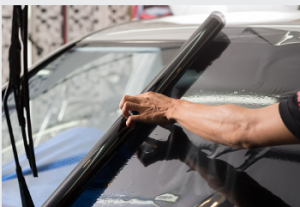Having your window tinting is beneficial for protecting you and your car and adds an aesthetic quality to your vehicle. You can find tints that offer UV protection, absorb solar heat, and even block infrared radiation. So whether you have a convertible or a full-size SUV, you can benefit from tinting your windows with a dyed film.
Dyed film tints enhance the appearance of your car.
Dyed film tints are a great way to enhance the look of your vehicle. They also protect you from UV rays that can cause severe damage to your upholstery and dashboard.
 There are many types of window tints, so it’s essential to learn more about them. The best window tint for you depends on your personal preferences, budget, and needs. Choosing the proper window film can save you money in the long run.
There are many types of window tints, so it’s essential to learn more about them. The best window tint for you depends on your personal preferences, budget, and needs. Choosing the proper window film can save you money in the long run.
Consider a full-featured ceramic window film if you want the best value for your buck. These can provide UV-blocking power and other comfort enhancements. This type of window film can be more expensive to produce than a dyed one, but most drivers find the added cost well worth the benefits.
Getting a hybrid tint will not only make your ride a cooler place, but it will also help you save a few bucks in the long run.
Dyed film tints block UV rays.
If you want to reduce the number of UV rays coming through your car windows, there are a few options. These include dyed, hybrid, and metallic window tints. Each has its advantages and disadvantages.
Dyed and metallised window tints use tiny metal particles to block UV rays. The result is a less expensive alternative with durability and a longer lifespan. It is also scratch-resistant and reflects heat away from the vehicle’s inside.
Glare control is another essential feature of window tints. It can help improve your viewing of the road and decrease the temperature of the interior.
Although most dyed and hybrid films have admirable heat rejection properties, they may not do as much to reduce UV rays as other types of window tint. One of the best options for lowering UV rays is glare control, which is guaranteed to perform year-round.
Metalized and hybrid window tints are both effective at blocking UV rays. However, the metalised version can interfere with the vehicle’s cell phone signals, GPS, and other systems.
Dyed film tints absorb solar heat.
Dyed film car window tints are made of multiple layers of dyed film that reflect the sun’s heat away from the inside of your vehicle. The film also reduces glare. However, this type of window tint is less effective in reducing UV rays than other types.
The carbon film is an excellent choice to block the sun’s rays from damaging your upholstery. It is also resistant to fading and keeps your car cool.
Xpert Tinting car window tinting is the highest quality window film. These films are shatterproof and non-conductive. It means they do not interfere with cell phones and GPS reception. They are also easy to clean.
Metallic window film uses invisible metallic particles embedded in the film layer to reflect heat. These particles improve the durability of the window and the overall strength of the window.
Hybrid window tint is a combination of metalised and dyed film. The metallised portion is usually titanium metallic flakes or grey dye. These films are popular because they provide high privacy and UV-ray protection.
There are many types of window tints available on the market. It needs to be clearer to decide which one to choose. You’ll find several different brands, materials and technologies.
For example, carbon film has a dark matte finish, which helps keep your car cool. It also blocks at least 40% of infrared light. Unfortunately, dyed films are prone to fading.
Although most dyed films are not as influential as other types in blocking heat, they are affordable and can be adjusted to a desired level of darkness.
Both ceramic and metallic window films offer excellent UV rays protection and maximum visibility. However, the metallised film can interfere with your GPS and cell phone signal.
Dyed film tints block infrared radiation.
The main difference between metallised and ceramic tints is their ability to reduce the heat in the car. Metalised window tints reflect heat away from the vehicle, while ceramic tints block heat.
Another key difference is the durability of each type. Metalised window tints are more resistant to scratches and fade. Ceramic films are more expensive to produce but have more heat rejection.
The two types of window tints effectively prevent UV rays from damaging the inside of your vehicle. Some films even block the sun’s glare and heat. But if you want an affordable option, a dyed film is the way.
There are several tint shades, but most opt for black, bronze, or grey. In addition, you can choose to have a film installed with a 5% VLT, allowing 70 per cent of the visible light to pass through.
